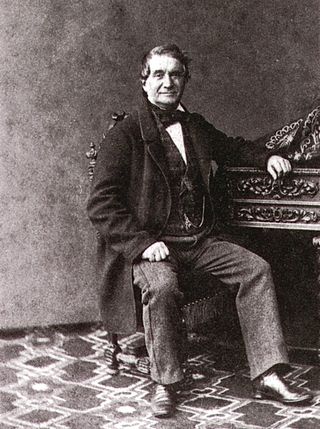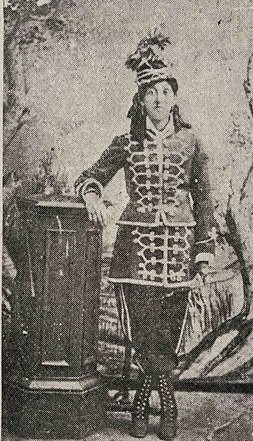Vivandière may refer to:
- Vivandière a generic name for women attached to military regiments
- La Vivandière , multiple stage works with this title
Vivandière may refer to:
English usually refers to:
The Kearny Medal and subsequent Kearny Cross were unofficial military decorations awarded by units of the United States Army during the American Civil War.
XXXX may refer to:

Cesare Pugni was an Italian composer of ballet music, a pianist and a violinist. In his early career he composed operas, symphonies, and various other forms of orchestral music. Pugni is most noted for the ballets he composed for Her Majesty's Theatre in London (1843–1850), and for the Imperial Theatres in St. Petersburg, Russia (1850–1870). The majority of his ballet music was composed for the works of the ballet master Jules Perrot, who mounted nearly every one of his ballets to scores by Pugni. In 1850 Perrot departed London for Russia, having accepted the position of Premier maître de ballet of the St. Petersburg Imperial Theatres at the behest of Carlotta Grisi, who was engaged as Prima ballerina. Cesare Pugni followed Perrot and Grisi to Russia, and remained in the imperial capital even after Grisi's departure in 1853 and Perrot's departure in 1858. Pugni went on to compose for Perrot's successors Arthur Saint-Léon and Marius Petipa, serving as the Imperial Theatre's official composer of ballet music until his death in 1870. He was also the grandfather of Russian painter Ivan Puni, also known as Iwan Puni and Jean Pougny.
Tepe may refer to:
Sarah Jane Taylor, was a vivandière for the Union during the American Civil War. She was the stepdaughter of Col. James A. Doughty, a Knoxville native who served as a captain in the 1st Regiment Tennessee Volunteer Infantry at Camp Dick Robinson in Kentucky, and the daughter of William and Betsy Keith Taylor of Anderson County, Tennessee.

Camp followers are civilians who follow armies. There are two common types of camp followers; first, the spouses and children of soldiers, who follow their spouse or parent's army from place to place; the second type of camp followers have historically been informal army service providers, servicing the needs of encamped soldiers, in particular selling goods or services that the military does not supply—these have included cooking, laundering, liquor, nursing, sexual services and sutlery.
None may refer to:

Arthur Saint-Léon was the Maître de Ballet of St. Petersburg Imperial Ballet from 1859 until 1869 and is famous for creating the choreography of the ballet Coppélia.

Henri Cain was a French dramatist, opera and ballet librettist. He wrote over forty librettos from 1893 to his death, for many of the most prominent composers of the Parisian Belle Epoque.

Vivandière or cantinière is a French name for women who are attached to military regiments as sutlers or canteen keepers. Their actual historic functions of selling wine to the troops and working in canteens led to the adoption of the name 'cantinière' which came to supplant the original 'vivandière' starting in 1793. The use of both terms was common in French until the mid-19th century, and 'vivandière' remained the term of choice in non-French-speaking countries such as the US, Spain, Italy, and Great Britain. Vivandières served in the French army up until the beginning of World War I, but the custom spread to many other armies. Vivandières also served on both sides in the American Civil War, and in the armies of Spain, Italy, the German states, Switzerland, and various armies in South America, though little is known about the details in most of those cases as historians have not done extensive research on them.

La Vivandière is a ballet in one act with choreography by Arthur Saint-Léon and Fanny Cerrito, and music by Cesare Pugni.
La Vivandière may refer to:

The 2nd Michigan Infantry Regiment was an infantry regiment that served in the Union Army during the American Civil War.

Lorinda Anna Blair Etheridge was a Union nurse and vivandière who served during the American Civil War. She was one of only two women to receive the Kearny Cross. She was inducted into the Michigan Women's Hall of Fame in 2010.
Lidija Horvat-Dunjko is a Croatian soprano vocalist and a Docent at the Zagreb Academy of Music. She was awarded the highest Croatian national decoration for her achievement in culture, the Order of Danica Hrvatska with the image of Marko Marulić. Her opera roles include The Queen of the Night in The Magic Flute and Gilda in Rigoletto. Along with Magazin, she finished sixth at the Eurovision Song Contest 1995, performing the song "Nostalgija", which achieved success in the country at the time.
A cigarette is a small roll of finely cut tobacco leaves wrapped in a cylinder of thin paper for smoking.

La Vivandière; or, True to the Corps! is a burlesque by W. S. Gilbert, described by the author as "An Operatic Extravaganza Founded on Donizetti's opera, La figlia del regimento." In the French or other continental armies a vivandière was a woman who supplied food and drink to troops in the field.

Juana López was a Chilean vivandière during the War of the Pacific. An officer's saber surrendered to López is now preserved in the collection of the National Historical Museum of Chile.
Chiro may refer to: